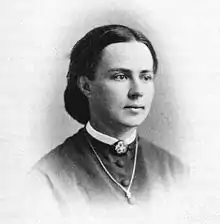

Marie Heim-Vögtlin (7 October 1845 in Bözen – 7 November 1916 in Zürich) was the first female Swiss physician, a writer and a co-founder of the first Swiss gynaecological hospital.
Education
Born as the daughter of the pastor of Bözen, Marie Vögtlin benefited from a private education in the Romandie and in Zürich. In 1867, her fiancé, a student of medicine, broke off the engagement. He married Nadezhda Suslova, Europe's first female physician, instead. In response and with the reluctant support of her father, Vögtlin applied for admission herself to the study of medicine at the University of Zürich, which had been the first medical faculty in Europe to admit women. This caused a national scandal,[1] as previously, only a few "impudent" foreign women such as Suslova had been matriculated there.
At the university, Vögtlin and her few fellow women students benefited from particular support by the faculty, even as many conservatives decried the medical education of women as shameful, and as a waste of time.[1] After Vögtlin passed the examinations with honours,[2] she studied gynaecology in Leipzig and worked in a Dresden maternity ward. On 11 July 1874 she attained her doctorate in Zürich with a dissertation on the topic of the state of the female genitalia in labour. It required the intervention of her father for her to obtain an official permission to practice medicine in Zürich.
Professional and family life
Although her practice had few clients at first, Vögtlin soon acquired a reputation as a capable and well-liked physician, and was particularly noted for her generosity towards poor women.[1]
In 1875, she married the noted geologist Albert Heim after he had given his permission (as required by law at that time) for her to continue working after marriage.[1] The couple had two children, Arnold and Helene, and also cared for a foster child. In 1916, Marie Heim-Vögtlin died of a lung disease.
Social activism
Marie Heim-Vögtlin was a co-founder of the Schweizerische Pflegerinnenschule mit Spital, Switzerland's first gynaecological hospital, which also featured a maternity ward and nurses' school. After the school opened in 1901, she served as its bursar. She was an active participant in the women's suffrage and temperance movements and published several works, mostly popular writings for women and children.[2]
Honours
The Swiss National Science Foundation (SNSF) has named a women's scholarship in Marie Heim-Vögtlin's honour. In 1995, a lane near the Zürich women's hospital was named after her. In 2010, Marie Heim-Vögtlin's work was honoured by the Gesellschaft zu Fraumünster.[3][4] In 2016, the hundredth anniversary of her death is commemorated with a Swiss Post stamp.[5]
References
- Müller, Verena E. "Kampf und Krampf". Libernensis, Zeitschrift der Universitätsbibliothek Bern (in German). University Library of Berne (1/2008): 26. ISSN 1660-2439.
- Müller, Verena E. (2008). Marie Heim-Vögtlin – die erste Schweizer Ärztin (1845–1916): Ein Leben zwischen Tradition und Aufbruch (in German) (2nd ed.). hier+jetzt Verlag. ISBN 978-3-03919-061-4.
- Siebel, Johanna (1925). Das Leben von Frau Dr. Marie Heim-Vögtlin, der ersten Schweizer Ärztin (in German). Leipzig: Rascher.
- Ogilvie, Marilyn Bailey; Harvey, Joy Dorothy (2000). The Biographical Dictionary of Women in Science. Taylor & Francis. p. 580. ISBN 0-415-92039-6.
Footnotes
- 1 2 3 4 Müller (Libernensis).
- 1 2 Ogilvie.
- ↑ "Frauenehrungen" (in German). Gesellschaft zu Fraumünster. Retrieved 2014-11-30.
- ↑ "Frauenehrungen der Gesellschaft zu Fraumünster" (PDF) (in German). Gesellschaft zu Fraumünster. 2014. Archived from the original (PDF) on 2015-02-07. Retrieved 2014-11-30.
- ↑ "Swiss Post salutes country's first female doc".
External links
- Marie Heim-Vögtlin in the German National Library catalogue
- Marie Heim-Vögtlin Programme